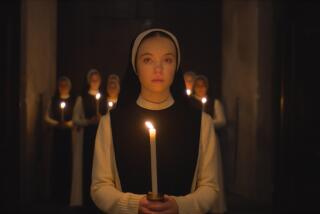A Quietly Frightening Dracula
There’s nothing suave or engaging or sympathetic about the vampire in F.W. Murnau’s “Nosferatu.” He’s just a blood-loving pervert--demented, creepy to look at and with no tortured past to show for his troubles.
He’s also the original. Murnau’s classic 1922 silent film, which launches the Newport Harbor Art Museum’s monthlong “Vampires in Our Midst” series Friday night, was the first to adapt Bram Stoker’s “Dracula.” Murnau, like Stoker, played it straight with the Transylvanian count: He’s hideous, not likable at all.
It took a succession of later movies to give the vampire anti-hero status and a sheen of sexiness and melancholy on top of the horror. Remember smooth, misunderstood Frank Langella in the 1979 rehash? And what did Francis Ford Coppola have in mind with his recent try? His Dracula (miscast with Gary Oldman; now that’s shocking) was an abomination of modern psychology, more moody than monstrous.
Murnau, whose reputation rests primarily on three films--besides “Nosferatu,” “The Last Laugh” (1925) and “Sunrise” (1927)--was a director well-suited to the silents. Coming out of the German Expressionist movement (he started as an avant-garde stage director), Murnau emphasized the medium’s stark image potential, discovering that his moving pictures could have the same impact as, say, a static painting by Edvard Munch.
Plotting, even acting, take a secondary role in “Nosferatu”--even when the familiar story slows down under Murnau’s deliberate exposition, a string of eerie visuals dig in.
Dracula, with his crazy great-goblin features, is the most obvious, but his shadow is even scarier: Murnau lets the silhouette of his root-like fingers stretch threateningly over the walks as he stalks a victim.
Shadows, and the use of light and dark, are really the movie’s motif. Murnau takes us into the bleak corridors of the count’s castle (and later, his manse in Bremen) where everything looks as if it’s in an advanced stage of rot.
Then, we’re thrown outside, where the sunlight is almost glaring. This contrast gives Jonathan (Gustav von Wangenheim), Nina (Greta Schroder) and the professor’s (John Gottowt) descent into his lair all the more foreboding.
The exaggerated gestures so typical in silents are used by most of Murnau’s cast, but with one exception. As Dracula, Max Schreck lets his distorted features do the talking.
He stares menacingly, making all the points he needs. And when he does speak, it’s with a weird touch of humor. At one point, he admires a photo of Nina and almost smacks his lips: “Is this your wife?” he asks. “What a lovely throat.”
The series continues April 2 with the most famous of the Dracula adaptations, “Dracula,” released in 1931 and starring Bela Lugosi. On April 16, “Dracula Has Risen From the Grave” (1968) will be offered.
Moving far from Transylvania, the series will screen “The Little Shop of Horrors” (1986) on April 23, and conclude April 30 with “Batman Returns.”
More to Read
The biggest entertainment stories
Get our big stories about Hollywood, film, television, music, arts, culture and more right in your inbox as soon as they publish.
You may occasionally receive promotional content from the Los Angeles Times.









